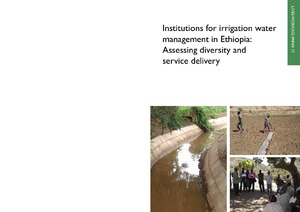Resource information
Irrigation systems cannot en sure the equitable distribution of water among users and sustainable operation and maintenance of the schemes without capable irrigation institutions. In Ethiopia, traditional institutions have emerged with the expansion of traditional irrigation schemes and most of them were established and operated on the initiative of the farmers. These often have very limited financial and technical capacities. Current trends show that developing infrastructure is the major concern in irrigation development efforts. However, managing the schemes is largely overlooked, particularly for externally initiated irrigation schemes. Operation and maintenance of the irrigation schemes, particularly those at tertiary levels, are commonly not well set and often neglected or left to farmers without building their capacities. The overarching objectives of the study were to: i) assess the nature and diversity of irrigation institutions in the study schemes; ii) evaluate existing institutions service delivery with respect to selected attributes and draw useful lessons; and iii) identify appropriate interventions. This study focused on 10 irrigation schemes located in four regional states of Ethiopia (Tigray, Amhara, Oromia and SNNP). Various approaches were used to generate data required for this study, such as household interview, transect walk and systematic observation, focus group discussion, key informant interviews and the review of existing literature. We clustered the study schemes as modern, semi-modern and traditional, using selected criteria (operation and maintenance service delivery, managing financial service delivery, level of inequity) to generate empirical evidence for evaluation of their performances. The results found two forms of irrigation institutions: irrigation water users associations (IWUA) and irrigation cooperatives or water committee. More than 30% of the irrigation schemes considered in the study, regardless of their typology, had no institution. Membership in the irrigation institution for traditional schemes was 100%, while the average membership both in modern and semi-modern schemes was about 70% of the respondents. This contrasts with the new proclamation in Ethiopia on IWUA which suggest mandatory membership for any water user in a scheme. Without exception bylaws were either not detailed enough to address scheme specific problems or not recorded at all. Ambiguity associated with these, and probably presence of non-member water users, deterred the decision-making processes and the enforcement of rules and regulations for water use, thus create opportunities for free riders. This also explains the reason for occasional conflict between irrigators and the inequity of water distribution within scheme. In many cases, irrigation institutions service delivery limited to operational management and other services, such as financial management, were not common even at those schemes where irrigation fee exists. Problems associated with a lack of empirical evidence as to what to pay for and how much to pay and the application of flat rate—regardless of the amount of irrigation water used, which is not measured—and crop types grown as currently practised will not act as an incentive for prudent water use. Establishing the amount and types of irrigation water fees will be an important step to finance irrigation schemes. Understanding this diversity and these gaps and tailoring actions to local conditions is vital efforts to improve the service delivery of irrigation institutions in Ethiopia. Secondly, the service required for the sustainable management of irrigation schemes and mechanisms to operate them needs to be standardized.



